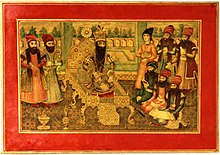Sun Throne
This article needs additional citations for verification. (April 2023) |


The Sun Throne (Persian: تخت خورشید, romanized: Takht-e Khurshīd) is the imperial throne of Iran. It takes its name from a radiant sun disk on the headboard. The throne has the shape of a platform, similar to the Marble Throne in Golestan Palace. The Naderi Throne was constructed later and has the appearance of a chair. Since 1980 it has been displayed at Iran's Central Bank.
History
[edit]
It was constructed for Fath-Ali Shah Qajar, Shah of Persia, in the early nineteenth century and was used as the coronation throne from then onwards. He took Tavous Khanum Taj ol-Doleh as one of his consorts. In English, her name translates to Lady Peacock. The marriage ceremony took place on the throne, and Tavous Khanum became his favourite wife. Due to her name, the throne later received the name "Peacock Throne" (Persian: تخت طاووس, romanized: Takht-e Tāvūs).[1] It was also theorised that parts of the plundered Mughal Peacock Throne were re-used, such as the legs or other parts, however no conclusive proof exists.
Not a single element on the Sun Throne features a peacock. The Lion and Sun was the ancient symbol of kingship in Persia. When the Shah would be seated on the throne, he symbolised the lion, with the sun symbol behind his back. The Shah himself however could also be seen as the sun. The last Shah, Mohammad Reza Pahlavi, carried the title Aryamehr (Light of the Aryans), which was another connotation for the sun.
Until 1980 the Sun Throne was located in the Mirror Hall of Golestan Palace. In 1980 it was decided to move it to the vaults of the Iranian Crown Jewels at Iran's Central Bank where it is now on display.
References
[edit]Further reading
[edit]- Curzon, George Nathaniel (1892). Persia and the Persian Question. London: Longmans, Green & Co.
External links
[edit]![]() Media related to Sun Throne at Wikimedia Commons
Media related to Sun Throne at Wikimedia Commons
